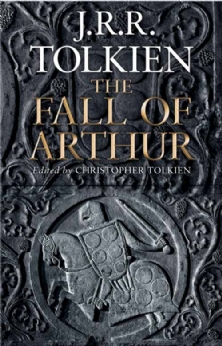J.R.R. Tolkien’s The Fall of Arthur, a never-before-published poem over 200 pages in length, will be released by HarperCollins in May 2013.
HarperCollins says Tolkien set aside this work to write The Hobbit and it was left untouched for 80 years:
The Fall of Arthur recounts in verse the last campaign of King Arthur who, even as he stands at the threshold of Mirkwood is summoned back to Britain by news of the treachery of Mordred. Already weakened in spirit by Guinevere’s infidelity with the now-exiled Lancelot, Arthur must rouse his knights to battle one last time against Mordred’s rebels and foreign mercenaries.
Christopher Tolkien edited the manuscript and wrote three essays for the book, (1) about the literary world of King Arthur, (2) the deeper meaning of the verses, and (3) his father’s work to bring it to a finished form.
The poem’s opening lines appeared in The Guardian:
Arthur eastward in arms purposed
his war to wage on the wild marches,
over seas sailing to Saxon lands,
from the Roman realm ruin defending.
Thus the tides of time to turn backward
and the heathen to humble, his hope urged him,
that with harrying ships they should hunt no more
on the shining shores and shallow waters
of South Britain, booty seeking.
John Lundberg observes how different this verse form is from that of 15th century poet by Thomas Malory in his piece for Huffpost Arts & Culture:
Tolkien, who passed away in 1973, took the Arthurian legends so far back, in fact, that he passed over hundreds of years wherein blank verse was the standard form of English epic poetry. That means his new poem won’t feature the rhythms you’d recognize from most English language epics, like translations of Dante’s The Divine Comedy … Tolkien instead embraced the Old English tradition of alliterative verse — the language of Beowulf and much of the medieval poetry he loved.
The stock question at times like this, against all sense, is whether Tolkien’s latest posthumous work will live up to The Hobbit, The Lord of the Rings, or even “Leaf by Niggle.” Despite what’s known about Tolkien’s procrastination and perfectionism, I believe it speaks for itself that any manuscript he left in the drawer is one he knew he was capable of improving if he chose to invest the effort. So Tolkien fans should be delighted to get a peek at The Fall of Arthur – which was by no means certain to happen – and be pleased if it is readable and appealing.
Discover more from File 770
Subscribe to get the latest posts to your email.


I’ve tried to read some of Tolkien’s work since his death and have found it largely dense, off putting and virtually unreadable.
Alliterative epic narrative verse is not generally the sort of thing the average modern reader is going to find particularly interesting. Only for Tolkien fans and Arthuriana buffs, I suspect.
One correction: though the book is over 200 pages long, the (incomplete) poem itself is 954 lines, according to Hammond and Scull. There are also outlines and drafts, and to make a book of that length there must be a lot of other ancillary material (commentary by CT, most likely) as well.
@DB: I couldn’t resolve whether the 200 page count was for the poem or the whole book. The Guardian’s phrasing indicates it’s the length of “Tolkien’s story.” The HarperCollins site does not yet specify the number of pages in the entire book.
Surely 200 pages sounds like a lot. For sake of discussion, how many pages of Williams’ Arthurian Torso, listed online as a 199-page book, is his own verse?
As the poem is stated by a reliable authority to be 954 lines long, to be 200 pages by itself would mean about five lines per page. Unlikely. Therefore it seems more than probable that 200 pages is the length of the whole book, and all of CT’s edited books since The Silmarillion have come with considerable editorial apparatus. Plus the fact that the poem also contains drafts and outlines likely to be printed with it.
For a fair comparison, the two main texts of The Legend of Sigurd and Gudrun occupied 178 pages of a volume of 377 pages, less than half of the whole.
It’s silly for me to entertain the possbility that Wayne and Christina didn’t personally count the lines in the MS. so I’ll move on… Beowulf, according to the Wikipedia, has over 3000 lines, and it fills only 108 pages of one translated edition. Extrapolating from that number, Tolkien’s Arthur will run about 30+ pages.
I read the whole of the Simirillion and might as well have been reading genuine medieval folderol about unbelievable, perfect knights, self-defeating chivalric love and unspeakably nasty villains without Celtic, Norse or Anglo-Saxon names. For a moldy fig like Tolkien, this was plainly hog heaven. For anyone except J.R.R. and about 25 of his peers in the entire United Kingdom, it was as pointless as anything can be. Why … it’s a pointless as most fiction written about fandom!
I’ve always held the thought in my mind that Tolkien’s other books should be issed as “Unreadable: Volume 1”, and so on.
One writer in Delaware issued a parody of THE SIMIRILLION, which as can be expected, sold a couple of copies.
Many of his lesser works, such as “Leaf by Niggle,” are quite readable, actually. Quite unpretentious too, which may be why they can be read with some pleasure.
Those were published while he was alive.